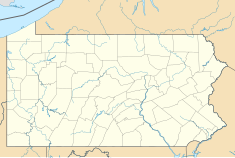
Scranton is a city in the Commonwealth of Pennsylvania, United States, and the county seat of Lackawanna County. With a population of 76,328 as of the 2020 U.S. census, Scranton is the largest city in Northeastern Pennsylvania and the Scranton–Wilkes-Barre–Hazleton Metropolitan Statistical Area, which has a population of 562,037 as of 2020. It is the seventh largest city or borough in Pennsylvania. The contiguous network of five cities and more than 40 boroughs all built in a straight line in Northeastern Pennsylvania's urban area act culturally and logistically as one continuous city, so while the city of Scranton itself is a mid-sized city, the larger Scranton/Wilkes-Barre Metropolitan Area contains nearly half a million residents in roughly 200 square miles. Scranton is the cultural and economic center of a region called Northeastern Pennsylvania, which is home to over 1.3 million residents.

The Delaware, Lackawanna and Western Railroad was a U.S. Class 1 railroad that connected Buffalo, New York, and Hoboken, New Jersey, a distance of 395 miles (636 km). Incorporated in Pennsylvania in 1853 primarily for the purpose of providing a connection between the anthracite coal fields of Pennsylvania's Coal Region and the large markets for coal in New York City. The railroad gradually expanded both East and West, eventually linking Buffalo with New York City.

The Rockville Bridge is the longest stone masonry arch railroad viaduct ever built, with forty-eight 70-foot spans and a total length of 3,820 feet (1,160 m). The bridge crosses the Susquehanna River about 5 miles (8 km) north of Harrisburg, Pennsylvania. The eastern end is in Rockville and the western end is just south of Marysville.

The Lackawanna & Wyoming Valley Railroad, more commonly known as the Laurel Line, was a Pennsylvania third rail electric interurban streetcar line which operated commuter train service from 1903 to 1952, and freight service until 1976. Its main line ran from Scranton to Wilkes-Barre.

The Delaware-Lackawanna Railroad is a shortline railroad operating in Northeastern Pennsylvania, especially the Scranton area.

The President Joseph R. Biden, Jr. Expressway, commonly referred to as the President Biden Expressway, and formerly known as the Central Scranton Expressway, is a short freeway southeast of downtown Scranton in the U.S. state of Pennsylvania. It runs east-southeast from U.S. Route 11 /Pennsylvania Route 307 near downtown to Interstate 81 (I-81).
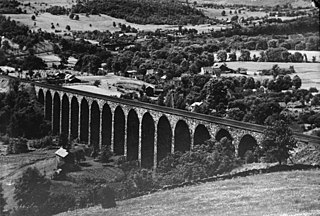
Starrucca Viaduct is a stone arch bridge that spans Starrucca Creek near Lanesboro, Pennsylvania, in the United States. Completed in 1848 at a cost of $320,000, it was at the time the world's largest stone railway viaduct and was thought to be the most expensive railway bridge as well. Still in use, the viaduct is listed on the National Register of Historic Places and is designated as a National Historic Civil Engineering Landmark.

Tunkhannock Creek Viaduct is a concrete deck arch bridge on the Nicholson Cutoff rail segment of the Norfolk Southern Railway Sunbury Line that spans Tunkhannock Creek in Nicholson, Pennsylvania. Measuring 2,375 feet (724 m) long and towering 240 feet (73.15 m) when measured from the creek bed, it was the largest concrete structure in the world when completed in 1915 and still merited "the title of largest concrete bridge in America, if not the world" 50 years later.

The Delaware River Viaduct is a reinforced concrete railroad bridge across the Delaware River about two miles (3.2 km) south of the Delaware Water Gap that was built from 1908 to 1910 as part of the Lackawanna Cut-Off rail line. It is the sister to the line's larger Paulinskill Viaduct. The Delaware River Viaduct also crosses Interstate 80 on the east side of the river and Slateford Road and the Lackawanna Railroad's "Old Road" on the west (Pennsylvania) side. Abandoned in 1983, it is part of an Amtrak proposal to introduce passenger service between Scranton, Pennsylvania and New York City, a distance of 135 mi (217 km).

The Marketplace at Steamtown is a shopping mall in Scranton, Pennsylvania. United States. It was conceived in the mid-1980s as the keystone of downtown revitalization, though the project was not completed until 1993. Its opening in 1993 was nationally televised on CNN and attended by then-Pennsylvania Governor Robert P. Casey, Sr., who was instrumental in securing funding for and initiating development of the mall. The mall is built on approximately half of the former Delaware, Lackawanna and Western Railroad yard that was abandoned by Conrail in the late 1970s. The mall is located on Lackawanna Avenue in the heart of downtown Scranton, and includes a parking garage that stretches the length of the mall between Boscov's and the former The Bon-Ton. The mall has two levels with a food court overlooking Steamtown National Historic Site on the second floor. There is a pedestrian bridge leading from the food court out to Steamtown. The mall was featured several times on the NBC sitcom The Office which was set in Scranton.
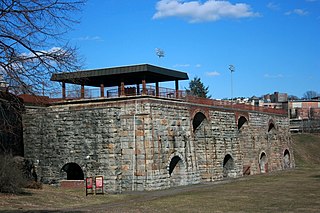
The Scranton Iron Furnaces is a historic site that preserves the heritage of iron making in the U.S. State of Pennsylvania and is located in Scranton, near the Steamtown National Historic Site. It protects the remains of four stone blast furnaces which were built between 1848 and 1857. Iron production on the site was started by Scranton, Grant & Company in 1840. Later, the furnaces were operated by the Lackawanna Iron & Coal Company. In 1847, iron rails for the Erie Railroad were made at the site. In 1865, Scranton, Grant & Company had the largest iron production capacity in the United States. In 1875, steel production started at the site. In 1880, the furnaces produced 125,000 tons of pig iron, one of the main uses of which was in the making of t-rails. The plant was closed in 1902, when production was shifted to Lackawanna, New York.

Abraham Burton Cohen was an American civil engineer notable for his role in designing innovative and record-breaking concrete bridges such as the Delaware, Lackawanna and Western Railroad's Tunkhannock Viaduct, the world's largest concrete structure when completed. Cohen was an active member of the American Concrete Institute and earned ACI's Wason Medal for Most Meritorious Paper in 1927.

The Hill to Hill Bridge is a road crossing of the Lehigh River and linking the south and north sides of Bethlehem, Pennsylvania in the Lehigh Valley region of the United States.
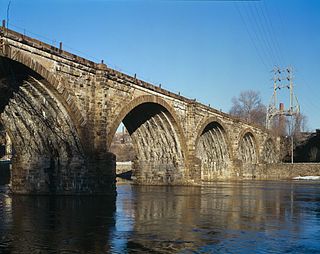
The Philadelphia and Reading Railroad, Schuylkill River Viaduct, also called the Reading Railroad Bridge and the Falls Rail Bridge, is a stone arch bridge that carries rail traffic over the Schuylkill River at Falls of Schuylkill in Philadelphia, Pennsylvania. Located in Fairmount Park, the bridge also spans Martin Luther King, Jr., Drive, and Kelly Drive. The name Philadelphia & Reading Railroad (P&R) was later shortened to Reading Company.
Lackawanna Transit Center is the main bus station and a proposed train station in Scranton, Pennsylvania, operated by the County of Lackawanna Transit System (COLTS).
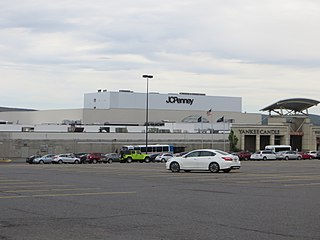
Viewmont Mall is a shopping mall located in Scranton, Pennsylvania. It is anchored by JCPenney, Macy's, Dick's Sporting Goods / Field & Stream, and HomeGoods.

The Conestoga Creek Viaduct spans the Conestoga River east of Lancaster, Pennsylvania. The present structure, built in 1887–88, is a five-span, two-track stone arch railroad bridge. The first crossing at this location was a 1,412 feet (430 m) series of 11 wooden Town lattice trusses constructed in 1829 for the Columbia and Philadelphia Railroad, which was purchased by the Pennsylvania Railroad (PRR) and incorporated into its main line in 1857. PRR shortened the viaduct and replaced the remaining wooden trusses with iron Whipple trusses in 1863. The 1887-88 stone arch replacement was originally intended to be four tracks wide, but only half of the superstructure width was constructed, leaving an unfinished spandrel wall on the southern face. Tie rods were added in 1930 to brace the spandrel walls.

The Scranton Lace Company, also known as the Scranton Lace Curtain Company and Scranton Lace Curtain Manufacturing Company, was an American lace manufacturer in Scranton, Pennsylvania.

Roaring Brook is a tributary of the Lackawanna River in Lackawanna County, Pennsylvania, in the United States. It is approximately 21 miles (34 km) long and flows through Covington Township, Madison Township, Moscow, Roaring Brook Township, Elmhurst Township, Dunmore, and Scranton. The watershed of the stream has an area of 56.3 square miles (146 km2). Its named tributaries include Little Roaring Brook, Rock Bottom Creek, White Oak Run, Van Brunt Creek, Bear Brook, and East Branch Roaring Brook. It has a high level of water quality for much of its length. However, it is affected by abandoned mining land, stormwater, and other impacts in its lower reaches. Reservoirs in the watershed include the Hollister Reservoir, the Elmhurst Reservoir, and others. The stream also flows through the Nay Aug Gorge and passes over the Nay Aug Falls, which are on the National Register of Geologic Landmarks. It flows through a concrete channel in its lower reaches. The topography of the watershed contains rolling hills in its upper reaches and the mountainous land of the Moosic Mountains in its lower reaches.

Paige Gebhardt Cognetti is an American politician serving as the 36th Mayor of Scranton, Pennsylvania. She is the first woman to be mayor of the city and won her seat in a special election. A member of the Democratic Party, she ran her first Scranton mayoral campaign as an Independent.



